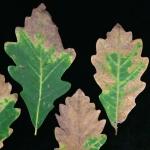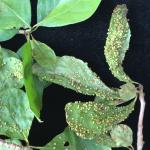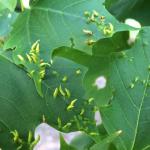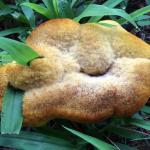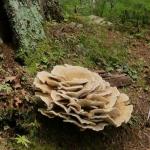UMass Extension's Landscape Message is an educational newsletter intended to inform and guide Green Industry professionals in the management of our collective landscape. Scouts compile and record environmental and phenological data for locations throughout Massachusetts to aid in the monitoring of plant and pest development, the planning of management strategies, and the creation of site-specific records for future reference. Detailed reports from Extension specialists on growing conditions, pest activity, and cultural practices for the management of woody ornamentals, trees, and turf are regular features. UMass Extension has updated the following issue to provide timely management information and the latest regional news and environmental data.
The Landscape Message will be updated bi-weekly July-September. The next message will be available on August 7. To receive immediate notification when the next Landscape Message update is posted, be sure to join our e-mail list.
Scouting Information by Region
Regional Notes
Cape Cod Region (Barnstable)
General Conditions: The weather pattern has been alternating between mild and dry and hot and humid. The Cape broke the 90º F mark on Monday, July 20, reaching 91º F in Marstons Mills, while the high temperature the previous Friday, July 17, only reached the upper 60s. Rainfall has been scarce and soils are once again dry. Hydrangea macrophylla, Bigleaf Hydrangea, is in full bloom, although on many plants the flowers are on the lower 2/3’s of the shrub. Hydrangea paniculata, Panicle hydrangea, is just beginning to bloom, while Hydrangea quercifolia, Oakleaf hydrangea, is in full bloom. Perennial gardens are bursting with blooms and it is high summer on the Cape!
Pests/Problems: The combination of dry soils and high soil temperature makes newly planted material subject to rapid wilting if not irrigated. Scorching of the leaf margins is a good indication that plants are suffering from water stress. Set irrigation systems to water deeply once or twice a week rather than 15 or 20 minutes daily. Male gypsy moths are flying, seeking the females. Adult females are large-bodied, white, and do not fly. Tan, quarter-sized egg masses will soon be apparent on tree trunks, foundations, or any structure that the female was on. Hibiscus sawfly larvae have finished the feeding stage. Japanese beetles have emerged and are feeding on foliage of a variety of annuals and roses. Other scarab beetles such as the Oriental and Asiatic garden beetles are also active. Damage from the Nantucket pine tip moth is becoming noticeable on pitch pines. Earwig damage can be seen on Zinnia. Check brown areas of turf for chinch bugs. Damage may appear to be drought stress but could also be chinch bugs, which thrive in hot weather. Crabgrass is getting big, as is red root pigweed and purslane. Jimson weed is beginning to bloom. Powdery mildew is active on phlox, beebalm, lilac, and rose. Black spot of rose is visible on susceptible cultivars. Hollyhock rust has been observed.
Southeast Region (Hanson)
General Conditions: Hot, humid weather has continued for the past two weeks with temperatures mostly in the 80’s, with a few days in the low nineties. Hanson received 2.25 inches of rain, early on these past two weeks, but no rain for the past week. With high temperatures, unirrigated soils are drying out and unirrigated plants are showing marginal leaf necrosis. Continue to remind clients to water newly planted trees and shrubs and drought-stressed plants, during this hot, dry weather. Oxydendrum arboreum (Sourwood Tree), Albizia julibrissin, Campsis radicans, Hydrangea paniculata ‘Praecox’ and other early cultivars, Weston hybrid azaleas, Hydrangea macrophylla, Hydrangea quercifolia (Oakleaf Hydrangea), Hydrangea arborescens (Smooth Hydrangea), Clematis, roses, Rose-of-Sharon, Rubus odoratus, Echinacea sp., Filipendula venusta, Asclepias tuberosa, Deinanthe caerulea, Platycodon sp., Hosta, Corydalis lutea, Persicaria polymorpha, Liatris spicata, Lysimachia clethroides, Actaea (formerly Cimicifuga) racemosa, Perovskia atriplicifolia, daylilies, Shasta daisy, Nepeta sp., Heliopsis ‘Summer Sun’, Helianthus sp., Hollyhocks, Monarda didyma (Beebalm), Silphium sp., Lavender, Rudbeckia sp., Asiatic lilies, Coreopsis sp., Astrantia major and Campanula sp. are in full bloom. Echinops ritro (Globe Thistle), Clerodendron trichotomum, Phlox paniculata (Garden Phlox), and Sedum sp. are beginning bloom. Stewartia pseudocamellia (Japanese Stewartia), Spigelia marilandica, and a few Kousa dogwoods continue to bloom.
Pests/Problems: Sunflower moth caterpillars (Homoeosoma electellum) were found in the flowers of Echinacea sp. and Heliopsis ‘Summer Sun’. The center of the flowers appeared brown and messy and when dissected, the small caterpillars were found. Gypsy moths began emerging from their pupae around July 8th. Large numbers of male gypsy moths were observed flying and pale tan-buff gypsy moth egg masses have been observed in many areas. Many trees have recovered from earlier defoliation from winter moth and gypsy moth caterpillars, but driving around, it is easy to see numerous trees that are still struggling to survive. Remind clients to water trees during these hot, dry days. Japanese, Oriental and Asiatic garden beetles continue to be active on a wide-range of plants. Biting flies (deer flies, horseflies, black horseflies) are active. Biting flies are attracted to dark, shiny moving objects as witnessed when my dark grey car was covered with deer flies while scouting! Here is a website with more information: http://entnemdept.ufl.edu/creatures/livestock/deer_fly.htm. The Asian Longhorned Beetle look-alikes, White-spotted Pine Sawyer and Graphisurus fasciatus (Longhorned Beetle) are active along with: earwigs, Rose curculio weevils, aphids, ticks, lily leaf beetles, slugs, snails, stinkbugs, four-lined plant bug, azalea lacebugs, Andromeda (Pieris) lacebugs, leafhoppers, wasps, hornets, carpenter bees, ticks, and mosquitoes. While there are currently no reports of Eastern equine encephalitis (EEE) being found in mosquito test pools, continue to take precautions against mosquitoes and ticks and use a repellent, like, DEET, when working outdoors. Monitor for viburnum leaf beetle, Redheaded Pine Sawfly and Introduced Pine Sawfly. Also, monitor for Asian Longhorned Beetles which may emerge in July, however, peak emergence is usually in August. Check this link for help on identifying Asian Longhorned Beetle: http://extension.umass.edu/landscape/sites/landscape/files/pdf-doc-ppt/recognize_alb_ppt.pdf. This link is helpful for reporting, if ALB is found: http://massnrc.org/pests/albdocs/ALBtreeguide.pdf. The pale green spots of Giant tar spot are beginning to show up on Norway maples. Later, these spots grow larger and turn black. For more information: https://ag.umass.edu/fact-sheets/giant-tar-spot. Powdery mildew continues to show up on flowering dogwood and it is really showing up on Phlox paniculata. Blackspot is showing up on susceptible roses. During these hot, humid days, the song of the “dog-day cicadas” can be heard. The heat has been a boon to weeds which are all doing quite well, especially crabgrass, clearweed and oxalis. Clover, Queen-Anne’s-Lace, Linaria vulgaris (Yellow toadflax) and fleabane continue to flower. Dock, oriental bittersweet, barberry and enchanters nightshade are setting seed.
North Shore Region (Beverly)
General Conditions: This reporting period was very warm and dry. Temperatures at Long Hil during this reporting period were in the high 70s and 80s during the day and mid 60s during the night. Temperatures 90 degrees and above were recorded on July 19th and 20th. Long Hill gained 306 growing degree days (GDD) during the last two weeks, and approximately 0.07 inches of rainfall were received. Woody plants seen in bloom include: Golden rain tree (Koelreuteria paniculata), Sourwood (Oxydendrum arboreum), Silk tree or Mimosa (Albizia julibrissin), Smoke bush (Cotinus coggygria), Big Leaf dogwood (Cornus macrophylla), Indigofera (Indigofera amblyantha), Oakleaf hydrangea (Hydrangea quercifolia), false spirea (Sorbaria arborea), Butterfly Bush (Buddleia davidii), and Rose-of-Sharon (Hibiscus syriacus). Herbaceous plants seen in bloom include: Bee balm (Monarda didyma), Shasta daisy (Leucanthemum x superbum), Yarrow (Achillea millefolium), Garden phlox (Phlox paniculata), Hostas (Hosta spp.), Sedums (Sedum spp.), Stachys (Stachys officinalis), Meadow rue (Thalictrum rochebrunianum), Sedums (Sedum spp.), Astilbe (Astilbe spp.), Summer flowering roses (Rosa sp.), Clematis vines (Clematis paniculata), Spiderwort (Tradescantia sp.), , Persicaria (Persicaria polymorpha) and Water lily (Nymphaea odorata). Adding even more color in the landscapes are an assortment of annuals.
Pests/Problems: Japanese beetles were observed in the landscape and are starting to cause damage on some plants. Also observed was heavy infestation of Brown Ambrosia Aphids (Uroleucon rudbeckiae) on Rudbeckia. Weeds are thriving due to moist soil and warm temperatures. Ticks and mosquitoes continue to be active.
East Region (Boston)
General Conditions: Temperatures have been average over the last two weeks; highs ranged from 72º F to 92º F (averaging 83º F), while lows ranged from 55º F to 72º F (averaging 65º F). We received some hot and humid weather from the 19th to the 21st as temperatures in the high 80’s and low 90’s were recorded. We received 1.80 inches of rain over the last two weeks, most of it coming during the morning of the 10th when 1.50 inches were accumulated over a two hour period. Color in the landscape is slowing down. Perennials currently in bloom include: Angelica gigas (giant angelica), Aralia californica (elk clover), Asclepias incarnata (swamp milkweed), Asclepias syriaca (common milkweed), Asclepias tuberosa (butterflyweed), Eutrochium spp. (Joe-Pye weed), Hibiscus moscheutos (rose mallow), Indigofera decora 'Roseum' (Chinese indigo), Lilium superbum (Turk’s cap lily), Perovskia atriplicifolia (Russian sage), Phlox carolina (Carolina phlox), Physostegia virginiana (obiedient plant), Platycodon grandiflorus (balloon flower), Rudbeckia fulgida 'Goldsturm' (black-eyed Susan), Silphium perfoliatum (cup plant), Solidago spp. (Goldenrod), and Tanacetum vulgare (tansy). Woody plants in bloom include: Albizia julibrissin (pink silk tree), Callicarpa cathayana (beautyberry), Calycanthus 'Venus' (sweetshrub), Castanea mollissima (Chinese chestnut), Cephalanthus occidentalis (common buttonbush), Clethra acuminata (mountain pepper bush), Cytisus supinus (bigflower broom), Daphne tangutica (daphne), Diervilla lonicera (northern bush honeysuckle), Euonymus carnosus (spindletree), Genista tinctoria (dyer's broom), Hydrangea arborescens (smooth hydrangea), Hydrangea radiata (silverleaf hydrangea), Hypericum kalmianum ‘Ames’ (St. Johnswort), Lonicera henryi (Henry's honeysuckle), and Rhododendron prunifolium (plumleaf azalea). Vines in bloom include: Clematis vitalba (traveler's joy), Clematis ‘Roguchi’, Clematis ‘Starfish’, Cocculus trilobus (Japanese snailseed), Lonicera periclymenum (common honeysuckle), Lonicera sempervirens (trumpet honeysuckle), and Wisteria frutescens (American wisteria).
Pests/Problems: Despite receiving 1.8 inches of rain since the last message, minimal precipitation over the last week plus the addition of warm and humid temperatures has left some plants in need of supplemental irrigation. Non-irrigated hydrangeas (Hydrangea ssp.) are especially showing signs of drought. Hickory limbs are cracking and breaking due to the excess weight of this year’s large nut crop. Weeds currently in bloom include: bittersweet nightshade (Solanum dulcamara), Carolina horsenettle (Solanum carolinense), orange jewelweed (Impatiens capensis), and purple loosestrife (Lythrum salicaria). Weeds in seed include: black swallowwort (Cynanchum louisae), broadleaf plantain (Plantago major), yellow nutsedge (Cyperus esculentus), and Virginia pepperweed (Lepidium virginicum). Male cicada killers (Sphecius speciosus) are active just as cicadas are beginning to emerge. Rust spots caused by cedar apple rust (Gymnosporangium juniperi-virginianae ) are visible on crabapple leaves (Malus spp.). Nymphs of Magnolia scale (Neolecanium cornuparvum), one of the largest scales in North America, have matured and are highly visible on Magnolia sieboldii (Oyama magnolia). Galls are starting to appear; Celtis sp. (hackberry) are showing signs of hackberry nipple gall, caused by psyllids.
Metro West (Acton)
General Conditions: 90 plus degree temperatures have finally been recorded for the first time this growing season! 91º was recorded on the 19th and was followed by a temp of 92º on the 20th. The Metro West area gained 294 GDD during this two-week recording period and received 1.25" of rain. The average rainfall for the month of July is 4.07" and rainfall recorded for this month thus far has been 1.78”. Woody plants seen in bloom this week are Aesculus parviflora (Bottlebrush Buckeye), Buddleia spp. (Butterfly Bush), Clerodendron trichotomum (Glorybower), Hibiscus syriacus (Rose-of-Sharon), Hydrangea arborescens (Smooth Hydrangea), H. paniculata (Panicle Hydrangea), H. quercifolia (Oakleaf Hydrangea), Koelreuteria paniculata (Goldenrain Tree), Oxydendron arboreum (Sourwood), Potentilla fruiticosa (Potentilla), P. tridentata (Cinquefoil), Rosa rugosa (Rugosa Rose), R. 'Knockout' (The Knockout family of Roses), Sambucus canadensis (American Elderberry), and Spirea japonica 'Alpina' (Daphne Spirea). Woody vines in bloom are Campsis radicans (Trumpet vine) and Clematis spp. (Clematis). Contributing even more color and interest to the landscape are some flowering herbaceous plants including: Achillea millefolium (Yarrow), Actaea racemosa (Black Cohosh), Alcea rosea (Hollyhocks), Asclepias syriaca (Common Milkweed), A. tuberosa (Butterfly Weed), Astilbe spp. (False spirea), Boltonia asteroids (Bolton’s Aster), Campanula takesimana 'Elizabeth' (Bellflower), Cichorium intybus (Chicory), Coreopsis verticillata (Threadleaf Coreopsis), Daucus carota (Queen Anne's Lace), Echinacea purpurea (Coneflower), Echinops ritro (Globe Thistle), Hemerocallis 'Stella D'Oro' (Daylily), H. fulva (Orange Daylily), H. spp. (Daylily), Heuchera spp. (Coral Bells), Hosta spp. (Plantain Lily), Lavendula angustifolia (Lavender), Leucanthemum sp. (Shasta Daisy), Liatris spicata (Spike Gayfeather), Lilium spp. (Lily), Limonium latifolium (Sea Lavender), Lychnis coronaria (Rose Campion), Lysimachia cletheroides (Gooseneck Loosestrife), Monarda didyma (Bee-Balm), Nepeta spp. (Ornamental Catmint), Oenothera macrocarpa (Ozark Sundrops), Perovskia atriplicifolia (Russian Sage), Phlox carolina (Carolina Phlox), Physostegia virginiana (obiediant Plant), Platycodon grandiflorus (Balloon Flower), Rudbeckia fulgida 'Goldsturm' (Black-Eyed Susan), Solidago spp. (Goldenrod), Thymus praecox (Thyme), Tradescantia sp. (Spiderwort), Veronicastrum virginicum (Culver's Root), and Yucca filamentosa (Yucca).
Pests/Problems: One of our most aggressive weeds, Cynachum nigrum (Black Swallowwort) is flowering and will be setting seed soon. Look closely for it growing in and amongst shrubs. It can be difficult to detect. More obvious weeds in bloom are Securigera varia (Crown Vetch) and Phytolacca americana (Pokeweed). Already setting seed and quite visible is Ailanthus altissima (Tree of Heaven). Look for it growing along roadsides and in parking lots and medians. Most importantly, begin to scout for the Asian Longhorned beetle because emergence seaon is upon us! Monitor the 13 host genera: Acer (Maple), Betula (Birch), Ulmus (Elm), Salix (Willow), Aesculus (Horsechestnut), Fraxinus (Ash), Platanus (Plane Tree), Populus (Poplar), Celtis (Hackberry), Sorbus (Mountain Ash), Albizia (Mimosa), Cercidiphyllum (Katsura) and Keolreuteria (Golden Raintree) for this invasive pest. Look for oviposition sites, frass and exit holes.
Central Region (Boylston)
General Conditions: The weather has vacillated between hot and humid, and lovely but somewhat cool days and nights for July. Annuals and vegetables are really filling in and generally blooming and fruiting well. Many perennials are at or near their peak including daylilies (Hemerocallis), Lilies (Lillium), Persicaria ‘Golden Arrow’, Geranium ‘Rozanne’, Geranium psilostemon, Astilbes, Shasta Daisy (Leacanthemum ‘Becky’), Corydalis lutea, Iris domestica, Hosta cultivars, Summer Phlox (Phlox paniculata), Russian Sage (Perovskia atriplicifolia), Catmint (Nepeta ‘Walker’s Low’), Knautia macedonica, Wild Senna (Senna hebecarpa), New York Ironweed (Vernonia noveboracensis), Wine Cups (Callirhoe involucrata), and Deinanthe caerulea. Other woody plants in bloom include Hydrangea arborescens ‘Hayes Starburst’, Indigofera amblyantha, Clematis jackmanii and C. ‘Princess Diana’. Clethra barbinervis (2015 Cary Award winner) is beginning to bloom.
Pests/Problems: Japanese beetles are active and feeding and are joined by Asiatic and Oriental Beetles. Spotted Knapweed is in bloom. Powdery mildew is showing up on Phlox paniculata, Monarda and Peonies. Wasp and hornet nest are enlarging.
Pioneer Valley Region (Amherst)
General Conditions: The dog days of summer are upon us as a hot and humid air mass settled over the Pioneer Valley from 7/19 to 7/21. Ambient air temperatures in the low 90s coupled with high humidity (dew points were in the upper 70s to near 80º F) sent the heat index soaring well over 100º F on the 19th and 20th. Two years ago, the region was gripped in a seven-day heat wave in mid-July so this latest heat spell was comparatively minor. Excluding the mini heat wave, high temperatures during July have been seasonable, reaching the mid- to upper-80s during the day and dropping down to the upper 50s to upper 60s at night. Rainfall from scattered, early evening thunderstorms has been very patchy throughout the valley over this past reporting period. Some towns have received abundant rainfall (>2ʺ) while others have received comparatively little (<0.5ʺ). As is often the case, many of these thunderstorms break up as they track east over the Berkshires from New York State, resulting in reduced accumulations when they reach the valley. Passing showers on 7/9 and 7/10 brought the most consistent rainfall throughout all areas of the valley since the soaking rain that started the month on 7/1. Overall, the landscape remains very green and healthy thanks to the abundance of rainfall in June and early July. Oaks are still pushing new growth in some settings, reflecting the abundance of soil moisture. The upper surface soil may be drying out in localized areas that have not received much rainfall since the 9th/10th so recently transplanted trees and shrubs should be monitored and provided with supplemental water as needed. Lawn grass remains green and growing strong, with most areas bouncing back nicely since the browning out in May. Crabgrass and yellow nutsedge are widespread and hitting their peak growth.
Pests/Problems: Root and butt rot fungi are beginning to emerge and careful scouting for annual fruiting bodies should take place for trees suspected of harboring these cryptic pathogens. Specifically, Phaeolus schweinitzii was observed fruiting near two large eastern white pines on the UMass Campus on Friday, 7/10 (pictured below). Bondarzewia, a root and butt rot pathogen of oak, was observed fruiting recently (also pictured below). Soon, Laeitporus (chicken of the wood) will also be producing its orange-colored, fleshy mushroom near the base or on the main trunk of infected oaks. Often times, this may be the only indication the tree is infected as symptoms are non-existent. Entomosporium leaf spot on hawthorn (Crataegus spp.) is beginning to appear. The leaf spots are very small and numerous, first appearing yellow in color and by September becoming brown to black. Entire leaves may be consumed leading to premature leaf shedding, especially on lower, shaded branches. However, because the trees are defoliated so late in the growing season, there is little, if any, impact on growth. Removal of discarded leaves is important to reduce inoculum present at the site. Tar spot on Norway maple is just beginning to emerge as well. While the disease appears as one large, black spot on the leaf surface, it is actually several small spots that have coalesced as they expand. Right now, the spots are pale green to yellow and are easily missed without close inspection. Management is not required. Lower branch dieback on Norway maple has also been observed in the landscape. Mostly, it appears to be affecting fully shaded branches in the understory. Norway maple anthracnose, caused by an undescribed Discula species, has been associated with the foliar collapse on samples submitted to the UMass Extension Plant Diagnostic Lab. Bladder galls, caused by eriophyid mites, are abundant on many different tree species right now (examples are pictured below). Japanese and Oriental beetles are widespread on the landscape now and damage can be observed on rose, crabapple, apple, and oak, among many other plants. Hand-picking these pests from infested plant parts is easier during cooler parts of the day when the beetles are not as active.
Berkshire Region (Great Barrington)
General Conditions: Dark clouds move in, rumbles of thunder can be heard, and the storm moves on after hardly a drop. That often was the pattern over the past two weeks. A few brief but heavy showers did occur at this site, but as with most summer thunderstorms, it is hit or miss. Enough rain fell to keep soil moisture levels high and to support growth of turfgrass and herbaceous garden plants. Temperatures were close to normal for highs but lows were often below normal with a cool 47º F on July 16 and 46º F on July 17. Daylilies are at their peak and are exceptional this year. Trumpet vine seems to have taken a beating this past winter as there was a considerable dieback and new vine growth has produced no flower buds. This also seems to be peak time for pollen based allergies and the degree of misery experienced by sensitive individuals is high.
Pests/Problems: Lily leaf beetle adults are particularly devastating and all that remains on many Oriental and Asiatic lilies is a naked stem. Pear slugs – the larval form of a sawfly – are numerous and can be found skeletonizing the leaves of pears, cherries, hawthorns, cotoneaster, and mountain ash. Two-spotted spider mites can be found feeding on a wide variety of trees, shrubs, and herbaceous plants. There are many overlapping generations through the summer. As such, there is the potential for major damage to landscape plants and vigilance and management of this pest is advised. The Japanese beetle population has increased over the past two weeks but numbers do not seem to be as great as in past years. Asiatic garden beetles are plentiful. Other numerous pests include: blacklegged ticks (nymph and larval stages), mosquitoes, no-see-ums (tiny biting flies), earwigs, ants, millipedes, centipedes, slugs, and snails. Powdery mildew has become more prevalent, but other disease pressures do not appear to be as great, except for various leaf spots.
Environmental Data
The following growing-degree-day (GDD) and precipitation data was collected for an approximately two week period, July 9 through July 22. Soil temperature and phenological indicators were observed on or about July 22. Total accumulated GDDs represent the heating units above a 50° F baseline temperature collected via our instruments for the 2015 calendar year. This information is intended for use as a guide for monitoring the developmental stages of pests in your location and planning management strategies accordingly.
|
Region/Location |
GDD |
GDD |
Soil Temp |
Precipitation |
|
Cape Cod |
289 |
1203 |
77 |
0.02 |
|
Southeast |
395 |
1,280 |
77 |
2.25 |
|
North Shore |
306 |
1234 |
69 |
0.07 |
|
East |
311.5 |
1393.5 |
74 |
1.80 |
|
Metro West |
294 |
1286.5 |
71 |
1.25 |
|
Central |
305 |
1322 |
62 |
1.79 |
|
Pioneer Valley |
323 |
1468 |
72.5 |
1.40 |
|
Berkshires |
262 |
1168 |
69 |
1.86 |
|
AVERAGE |
311 |
1294 |
71 |
1.31 |
|
n/a = information not available |
||||
Phenology
Phenological indicators are a visual tool for correlating plant development with pest development. The following are indicator plants and the stages of bloom observed for this period:
| Indicator Plants - Stages of Flowering (BEGIN, BEGIN/FULL, FULL, FULL/END, END) | ||||||||
|---|---|---|---|---|---|---|---|---|
| PLANT NAME (Botanic/ Common) | CAPE | S.E. | N.S. | EAST | METRO W. | CENT. | P.V. | BERK. |
| Polygonum cuspidatum (Japanese Knotweed) | * | * | * | * | begin | * | * | * |
| Buddleia davidii (Butterfly Bush) | begin/full | begin | full | begin/full | full | begin/full | full | full |
| Clethra alnifolia (Summersweet Clethra) | begin | * | begin | begin | begin | begin | begin | * |
| Hibiscus syriacus (Rose-of-Sharon) | begin | begin/full | full | begin | full | begin | full | full |
| Oxydendrum arboreum (Sourwood) | full | full | full | full | full | full | full | * |
| Campsis radicans (Trumpet Vine) | full | full | full | full | full | * | full | * |
| Koelreuteria paniculata (Goldenrain Tree) | full | full | full | full | full | * | full | * |
| Hydrangea paniculata (Panicle Hydrangea) | full/end | full | full/end | full/end | full/end | full | full | full |
| * = no activity to report/information not available | ||||||||
- CAPE COD REGION - Roberta Clark, UMass Extension Horticulturist for Barnstable County - Retired, reporting from Barnstable.
- SOUTHEAST REGION - Deborah Swanson, UMass Extension Horticulturist for Plymouth County - Retired, reporting from Hanson.
- NORTH SHORE REGION - Geoffrey Njue, Green Industry Specialist, UMass Extension, reporting from the Long Hill Reservation, Beverly.
- EAST REGION - Kit Ganshaw & Sue Pfeiffer, Horticulturists, reporting from the Arnold Arboretum, Jamaica Plain.
- METRO WEST REGION – Julie Coop, Forester, Massachusetts Department of Conservation & Recreation, reporting from Acton.
- CENTRAL REGION - Joann Vieira, Superintendent of Horticulture, reporting from the Tower Hill Botanic Garden, Boylston.
- PIONEER VALLEY REGION - Nick Brazee, Plant Pathologist, UMass Extension Plant Diagnostic Lab, reporting from UMass Amherst.
- BERKSHIRE REGION - Ron Kujawski, Horticultural Consultant, reporting from Great Barrington.
Woody Ornamentals
Diseases & Insects
Recent woody ornamental problems of interest seen in the UMass Extension Plant Diagnostic Laboratory:
Norway spruce gall midge (Piceacecis abietiperda) infestation of Norway spruce (Picea abies). Tree is approximately 60-years-old and tip dieback on lower canopy branches was observed in early summer. This emerging insect pest is non-native and appears to prefer specimen, landscape trees.
Infestations of the balsam woolly adelgid (Adelges piceae) and spruce spider mite (Oligonychus ununguis) on balsam fir (Abies balsamea). Tree has been present on the site for five years and has been symptomatic for three. Branch tips were swollen and distorted and then needles began browning at the top of the canopy progressing downward. White cottony masses of the balsam woolly adelgid were present on the branches and the main trunk. This non-native pest has killed millions of balsam fir since its introduction but is uncommon in landscape settings.
Stem cankering caused by Cytospora sp. on eastern hemlock (Tsuga canadensis), true fir (Abies sp.) and eastern white pine (Pinus strobus). Trees from three different sites, all in decline with other agents involved. While Cytospora is typically thought of as a pathogen of blue spruce, there are several species that attack a wide array of conifers in our region.
Stem cankering caused by Botryosphaeria on red twig dogwood (Cornus sericea ‘Cardinal’). Tree is approximately four-years-old and has been present at the site for only one year. Soils are wet at the site and symptoms of dieback appeared this spring. Stems were blackened with sunken lesions that, over time, will become ash-grey. Numerous spore-bearing pads of fungal tissue ruptured through the outer bark after incubation. Botryosphaeria can be a destructive pathogen on the shrub dogwoods because of their dense canopies and thin bark.
Branch cankering caused by Botryodiplodia hypodermia on Japanese elm (Ulmus davidiana var. japonica). Tree is 125-years-old and has been present at the site (UMass Amherst) for its entirety. Very localized yellowing and wilting of branches in the canopy was noted this summer. Botryodiplodia is a regular cankering pathogen of elm and symptoms can mimic flagging caused by Dutch elm disease.
Leaf spot of cherry (Prunus sp.) caused by Blumeriella jaapi. A very common pathogen on cherry and plum, several small leaf spots develop soon after leaves fully elongate. The necrotic spots often shrivel and fall out, producing the “shot hole” appearance. However, this symptom alone is not diagnostic of the disease. Several Prunus on the property, all approximately 15-years-old, shedding foliage prematurely.
Dutch elm disease caused by Ophiostoma novo-ulmi on American elm (Ulmus americana). Tree is roughly 30-years-old and has been present at the site for approximately 25 years. Significant root damage was inflicted three to five years ago when the adjacent road and sidewalk were reconstructed. No legitimate attempts were made to protect the tree’s root zone. In the years since, the tree has declined, with branch dieback worsening in 2015. Elm bark beetle galleries were present in a 2ʺ diameter branch and Ophiostoma was incubated from stained xylem tissue.
For more detailed management information for woody plant diseases in the landscape, refer to UMass Extension's Professional Management Guide for Diseases of Trees and Shrubs.
Report by Nick Brazee, Plant Pathologist, UMass Extension Plant Diagnostic Lab, UMass Amherst.
Additional Resources
To receive immediate notification when the next Landscape Message update is posted, be sure to join our e-mail list and follow us on Facebook and Twitter.
For a complete listing of upcoming events, see our Upcoming Educational Events page.
For commercial growers of greenhouse crops and flowers - Check out the New England Greenhouse Update website
For professional turf managers - Check out Turf Management Updates
For home gardeners and garden retailers - Check out home lawn and garden resources. UMass Extension also has a Twitter feed that provides timely, daily gardening tips, sunrise and sunset times to home gardeners, see https://twitter.com/UMassGardenClip
Diagnostic Services
A UMass Laboratory Diagnoses Landscape and Turf Problems - The UMass Extension Plant Diagnostic Lab is available to serve commercial landscape contractors, turf managers, arborists, nurseries and other green industry professionals. It provides woody plant and turf disease analysis, woody plant and turf insect identification, turfgrass identification, weed identification, and offers a report of pest management strategies that are research based, economically sound and environmentally appropriate for the situation. Accurate diagnosis for a turf or landscape problem can often eliminate or reduce the need for pesticide use. For sampling procedures, detailed submission instructions and a list of fees, see Plant Diagnostics Laboratory
Soil and Plant Nutrient Testing - The University of Massachusetts Soil and Plant Nutrient Testing Laboratory is located on the campus of The University of Massachusetts at Amherst. Testing services are available to all. The function of the Soil and Plant Nutrient Testing Laboratory is to provide test results and recommendations that lead to the wise and economical use of soils and soil amendments. For complete information, visit the UMass Soil and Plant Nutrient Testing Laboratory web site. Alternatively, call the lab at (413) 545-2311.
Ticks are active at this time! Remember to take appropriate precautions when working and playing outdoors, and conduct daily tick checks. UMass tests ticks for the presence of Lyme disease and other disease pathogens. Learn more
